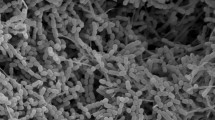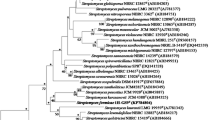Abstract
A putative novel clade within the genus Streptomyces was discovered following antifungal screening against Pseudogymnoascus destructans, the causative agent of white-nose syndrome, and described using multi-locus sequencing analysis. Swabs from both the cave myotis bat (Myotis velifer) and the Brazilian free-tailed bat (Tadarida brasiliensis) in southern New Mexico bore isolates AC536, AC541T and AC563, which were characterised using phylogenetic, morphological, and phenotypic analyses. Multi-locus sequence analysis positions AC541T with neighbors Streptomyces rubidus (NRRL B-24619T), Streptomyces guanduensis (NRRL B-24617T), and Streptomyces yeochonensis (NRRL B-24245T). A complete genome of the type strain was assembled to determine its taxonomy and secondary metabolite potential. ANI comparisons between all closely related types strains are shown to be well below the 95–96% species delineation. DNA-DNA relatedness between AC541T and its nearest neighbors ranged between 23.7 and 24.1% confirming novelty. Approximately 1.49 Mb or 17.76% of the whole genome is devoted to natural product biosynthesis. The DNA G + C content of the genomic DNA of the type strain is 73.13 mol %. Micromorphology depicts ovoid spores with smooth surfaces in flexuous chains. Strains presented an ivory to yellow hue on most ISP media except inorganic salts-starch agar (ISP4) and can grow on d-glucose, mannitol, and d-fructose, but exhibited little to no growth on l-arabinose, sucrose, d-xylose, inositol, l-rhamnose, d-raffinose, and cellulose. This clade possesses the capability to grow from 10 to 45 °C and 12.5% (w/v) NaCl. There was strain growth variation in pH, but all isolates thrive at alkaline levels. Based on our polyphasic study of AC541T, the strain warrants the assignment to a novel species, for which the name Streptomyces buecherae sp. nov. is proposed. The type strain is AC541T (= JCM 34263T, = ATCC TSD201T).



Similar content being viewed by others

References
Blehert DS (2012) Fungal disease and the developing story of bat white-nose syndrome. PLoS Path 8:e1002779
Blin K, Shaw S, Steinke K, Villebro R, Ziemert N, Less SY, Medema MH, Webber T (2019) Antismash 5.0: updates to the secondary metabolite genome mining pipeline. Nucleic Acids Res 47:W81–W87. https://doi.org/10.1093/nar/gkz310
Fisher MC, Gurr SJ, Cuomo CA, Blehert DS, Jin H, Stukenbrock EH, Stajich JE, Kahmann R, Boone C, Denning DW, Gow NA (2020) Threats posed by the Fungal Kingdom to humans, wildlife, and agriculture. mBio 11:e00449. https://doi.org/10.1128/mBio.00449-20
Hamm PS, Caimi NA, Northup DE, Valdez EW, Buecher DC, Dunlap CA, Labeda DP, Lueschow SR, Porras-Alfaro A (2017) Western bats as a reservoir of novel Streptomyces species with antifungal activity. Appl Environ Microbiol 83:e03057-16. https://doi.org/10.1128/AEM.03057-16
Hoyt JR, Langwig KE, Okoniewski J, Frick WF, Stone WB, Kilpatrick AM (2015) Long-term persistence of Pseudogymnoascus destructans, the causative agent of white-nose syndrome, in the absence of bats. EcoHealth 12:330–333. https://doi.org/10.1007/s10393-014-0981-4
Jolley KA, Maiden MC (2010) BIGSdb: scalable analysis of bacterial genome variation at the population level. BMC Bioinform 11:595. https://doi.org/10.1186/1471-2105-11-595
Kautsar SA, Blin K, Shaw S, Navarro-Muñoz JC, Terlouw BR, van de Hooft JJJ, van Santen JA, Tracanna V, Suarez-Duran HG, Pascal-Andreu V, Selem-Mojica N, Alanjary M, Robinson SL, Lund G, Epstein SC, Sisto AC, Charkoudian LK, Collemare J, Linington RG, Weber T, Medema MH (2020) MIBiG 2.0: a repository for biosynthetic gene clusters of known function. Nucleic Acids Res 48:D454–D458. https://doi.org/10.1093/nar/gkz882
Kumar S, Stecher G, Li M, Knyaz C, Tamura K (2018) MEGA X: molecular evolutionary genetics analysis across computing platforms. Mol Biol Evol 35:1547–1549. https://doi.org/10.1093/molbev/msy096
Kunz TH, Hodgkison R, Weise CD (2009) Methods of capturing and handling bats. In: Kunz TH, Parsons S (eds) Ecological and behavioral methods for the study of bats, 2nd edn. The John Hopkins University Press, Baltimore, pp 3–35
Labeda DP, Dunlap CA, Rong X, Huang Y, Doroghazi JR, Ju K-S, Metcalf WW (2017) Phylogenetic relationships in the family Streptomycetaceae using multi-locus sequence analysis. Antonie Van Leeuwenhoek 110:563–583. https://doi.org/10.1007/s10482-016-0824-0
Nei M, Kumar S (2000) Molecular evolution and phylogenetics. Oxford University Press, New York
Richter M, Rosselló-Móra R (2009) Shifting the genomic gold standard for the prokaryotic species definition. PNAS 106:19126–19131. https://doi.org/10.1073/pnas.0906412106
Rong X, Huang Y (2012) Taxonomic evaluation of the Streptomyces hygroscopicus clade using multi-locus sequence analysis and DNA-DNA hybridization, validating the MLSA scheme for the systematics of the whole genus. Syst Appl Microbiol 35:7–18
Shirling EB, Gottlieb DA (1966) Methods for characterization of Streptomyces species. Int J Syst Bacteriol 16:313–340
Turner GG, Reeder DM, Coleman JTH (2011) A five-year assessment of mortality and geographic spread of white-nose syndrome in North American bats and a look to the future. Bat Res News 52:13–27
Xu C, Wang W, Cui Q, Huang Y, Liu Z, Zheng G, Goodfellow M (2006) Neutrotolerant acidiphilic Streptomyces species isolated from acidic-soils in China: Streptomyces guanduensis sp. nov., Streptomyces paucisporeus sp. nov., Streptomyces rubidus sp. nov. and Streptomyces yanglinensis sp. nov. Int J Syst Evol Microbiol 56:1109–1115
Yoon SH, Ha SM, Lim J, Kwon S, Chun J (2017) A large-scale evaluation of algorithms to calculate average nucleotide identity. Antonie Van Leeuwenhoek 110:1281–1286. https://doi.org/10.1007/s10482-017-0844-4
Zukal J, Bandouchova H, Bartonička T, Berkova H, Brack V, Brichta J, Dolinay M, Jaron KS, Kovacova V, Kovarik M, Martínková N, Ondracek K, Rehák Z, Turner GG, Pikula J (2014) White-nose syndrome fungus: a generalist pathogen of hibernating bats. PLoS ONE 9:e97224
Acknowledgements
PSH and APA thank support from Western Illinois University and their Research Inspiring Student Excellence (RISE) and Women in Science (WIS) programs. CAD was supported by ARS National Programs 303, 304 and 306. DEN gratefully acknowledges the support of the staff at Carlsbad Caverns National Park with logistical support and assistance with the NPS Materials Transfer Agreement implementation. We would like to thank Dr. Ernest W. Valdez for providing expertise on bats. Any opinions, findings, conclusions, or recommendations expressed in this publication are those of the author(s) and do not necessarily reflect the view of the U.S. Department of Agriculture or the National Science Foundation. The mention of firm names or trade products does not imply that they are endorsed or recommended by the USDA over other firms or similar products not mentioned. USDA is an equal opportunity provider and employer.
Funding
Initial funding was provided by the Eppley Foundation (DEN). Additional funding was provided by the IDNR (APA) and the Colorado Plateau Cooperative Ecosystem Studies Unit (CPCESU) (DEN). The lead author (PSH) would like to thank the Mycological Society of America for funding to present her research. This publication was also supported by the National Cancer Institute (NCI) of the National Institutes of Health (NIH) under Award Number F32CA221327 (MWM) and the National Center for Complementary and Integrative Health (NCCIH) of the NIH under Award Number R01AT009143 (RJT, NLK). This material is based upon work supported by the National Science Foundation (APA).
Author information
Authors and Affiliations
Contributions
PSH: Wrote the paper, Collected phenotypic and morphological data. CAD: Wrote the paper, performed genomic and phylogenetic analysis. MWM: Wrote the paper, Performed genomic and BGC analysis. NAC: Collected cultures. NLK: Obtained funding. RJT: Obtained funding. AP-A: Obtained funding, Reviewed/edited manuscript. DEN: Obtained funding, Collected the bats and cultures, Reviewed/edited manuscript.
Corresponding author
Ethics declarations
Conflict of interest
The authors declare no conflicts of interests in the manuscript.
Additional information
Publisher's Note
Springer Nature remains neutral with regard to jurisdictional claims in published maps and institutional affiliations.
The GenBank accession number for complete genome of Streptomyces buecherae AC541T is CP060404.
Electronic supplementary material
Below is the link to the electronic supplementary material.
Rights and permissions
About this article
Cite this article
Hamm, P.S., Dunlap, C.A., Mullowney, M.W. et al. Streptomyces buecherae sp. nov., an actinomycete isolated from multiple bat species. Antonie van Leeuwenhoek 113, 2213–2221 (2020). https://doi.org/10.1007/s10482-020-01493-4
Received:
Accepted:
Published:
Issue Date:
DOI: https://doi.org/10.1007/s10482-020-01493-4



